You’ve probably admired intricate gold jewelry without realizing the ancient secrets behind its creation. Viking artisans mastered granulation—a technique so sophisticated that modern jewelers still struggle to replicate it perfectly. They transformed tiny gold spheres into elaborate patterns that weren’t just decorative but carried deep spiritual meanings and announced social status. What you’re about to discover will change how you view these remarkable craftsmen and their lost methods forever.
Ancient Origins of Granulation Technique in Viking Metalworking

While most people associate granulation with ancient Mediterranean civilizations, this intricate metalworking technique actually traveled far beyond its origins to influence Viking craftsmen across Northern Europe.
You’ll discover that granulation first emerged among the Etruscans during the 3rd to 2nd centuries B.C., who mastered the art of applying tiny metal spheres to create stunning decorative patterns.
The technique spread through Anatolia, Syria, and Troy before reaching Viking territories by the late 8th century.
You can see how Viking metalworkers adapted these ancient methods, incorporating granulation into their own distinctive style of ancient jewellery.
This artistic exchange demonstrates how cultural techniques transcended geographical boundaries, ultimately becoming integral to Viking society’s sophisticated goldsmithing traditions and social expression.
Materials and Tools Used by Viking Goldsmiths for Granulation
When Viking goldsmiths initiated the creation of granulated jewelry, they carefully selected high-karat gold—typically 22 kt—and silver alloys that would provide both durability and the lustrous finish their noble patrons demanded.
You’d find them creating tiny spheres from these same precious metals, meticulously sorting each granule for uniform size before application.
Their toolkit included specialized instruments like the rochoir for mixing solder and flux, while crucibles fired the granules into perfect spheres.
The granulation process required colloidal soldering—an advanced technique using tragacanth gum and copper salts that bonded granules at lower temperatures.
This sophisticated approach to gold jewellery demonstrates how Viking artisans mastered both material selection and tool craftsmanship to achieve their remarkable granulated pieces.
The Colloidal Soldering Method: Viking Mastery of Eutectic Fusion
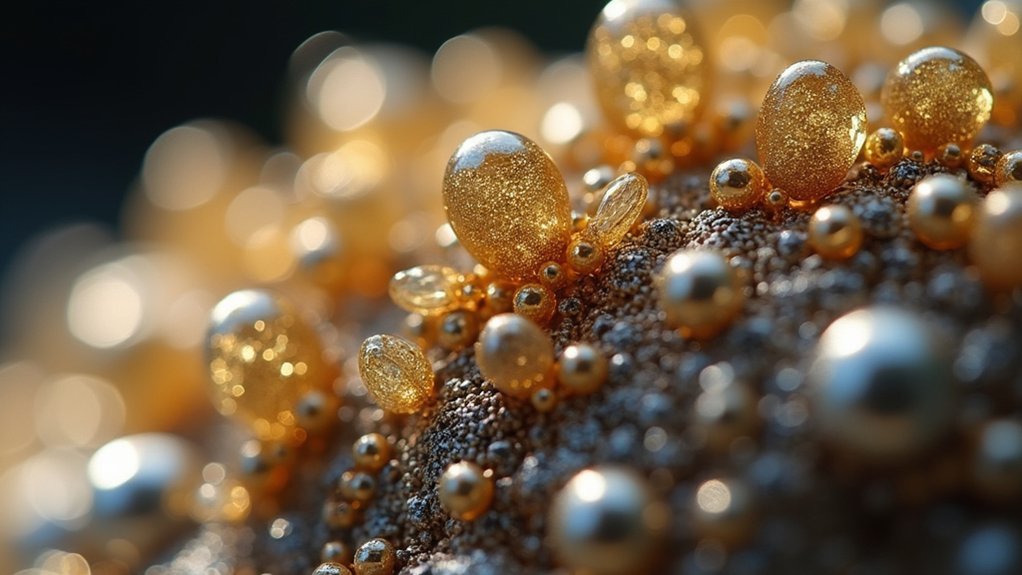
You’ll discover that Viking goldsmiths mastered a revolutionary technique called colloidal soldering, which used copper salts mixed with tragacanth gum to create eutectic fusion at dramatically lower temperatures.
This chemical process didn’t require traditional flux, instead allowing copper to diffuse naturally into both the tiny granules and base metal through precise molecular bonding.
You’re witnessing an ancient form of chemical engineering that enabled Vikings to attach microscopic gold spheres with incredible strength and accuracy.
Ancient Copper Salt Techniques
Although modern jewelers rely on sophisticated torches and precision instruments, Viking craftsmen achieved remarkable granulation effects through an ingenious colloidal soldering method that combined tragacanth gum with copper salts.
You’d find their gold techniques required extraordinary craftsmanship, as they precisely mixed these materials to create bonds at lower melting temperatures than traditional methods demanded.
When you examine their process, the copper salt releases at approximately 890°C during eutectic soldering, enabling granules to fuse seamlessly with base metal surfaces.
You’ll notice this ancient technique demanded perfect timing—applying the colloidal solder required exceptional skill to prevent granule damage while ensuring effective bonding.
These sophisticated metalworking practices reveal the technological advancement underlying Viking jewelry production.
Eutectic Temperature Soldering Process
The colloidal soldering method represents the pinnacle of Viking metallurgical innovation, where craftsmen transformed basic materials into sophisticated bonding agents that revolutionized granulation techniques.
You’ll discover this eutectic temperature process involved mixing tragacanth gum with copper salts, creating a solution that dramatically lowered metal melting points at contact areas.
When heated to approximately 890°C, copper diffused into both granules and base metal, forming a robust connection that withstand centuries of wear.
This technique demanded exceptional timing and skill—you’d need to achieve perfect fusion without damaging delicate components.
The process created incredibly durable jewelry, as evidenced by surviving Indian earrings from the First Century B.C., showcasing the advanced craftsmanship Viking artisans mastered through this sophisticated eutectic fusion method.
Chemical Bonding Without Flux
When Viking artisans discovered they could create permanent metal bonds without traditional flux, they revealed a revolutionary technique that would define their jewelry-making legacy.
You’ll find their colloidal soldering method used a clever mixture of tragacanth gum and copper salts that dramatically lowered melting temperatures at precise contact points. This allowed them to achieve strong chemical bonds through copper diffusion into both granules and base metal during heating.
Viking techniques required extraordinary skill and timing.
You’d arrange granules made from identical alloys onto your base surface, then carefully paint the colloidal solution before firing. The copper would diffuse seamlessly during the heating process, creating permanent connections without any flux whatsoever.
This mastery enabled intricate patterns and elaborate designs that showcased their advanced understanding of metallurgy and innovative approach to creating durable, beautiful adornments.
Regional Variations in Viking Granulation Across Scandinavia
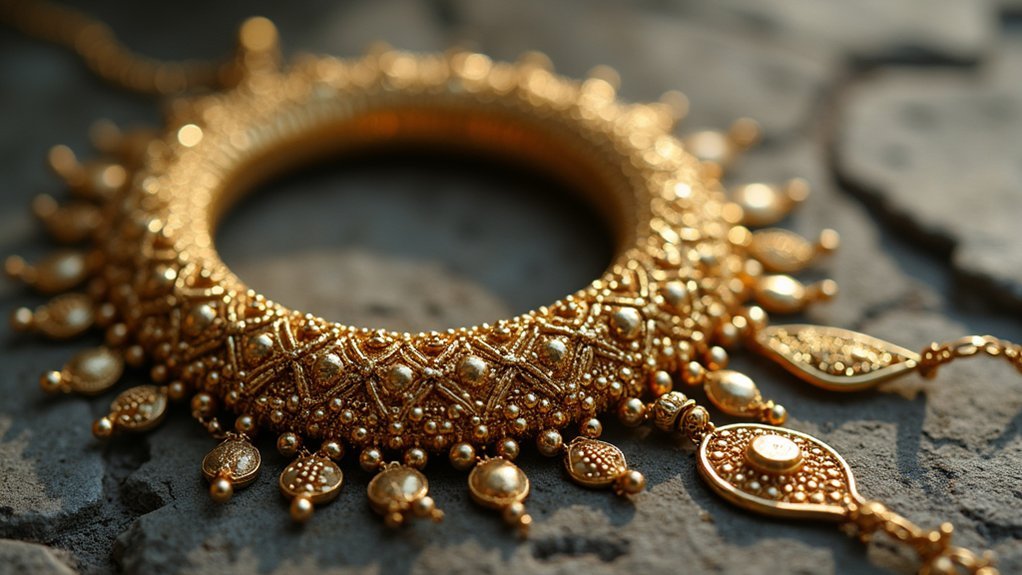
Across the vast expanse of Scandinavia, Viking artisans developed distinctly different approaches to granulation jewelry that reflected their local cultures and artistic sensibilities. These regional variations showcase how geography and cultural traditions influenced metalworking techniques across Norway, Sweden, and Denmark.
| Region | Style Characteristics | Cultural Influence |
|---|---|---|
| Norway | Natural motifs, mythological symbols | Local folklore traditions |
| Sweden | Geometric patterns, structured designs | Preference for symmetry |
| Denmark | Elaborate detail, decorative elements | Social status display |
You’ll notice that Norwegian granulation emphasized organic forms inspired by nature and mythology, while Swedish artisans favored clean geometric lines. Danish craftsmen created the most intricate pieces, designed to showcase wealth and social standing. These differences reveal interconnected trade routes and cultural exchanges throughout the Viking Age.
Archaeological Evidence From Birka and Hedeby Trading Centers
Although scattered across different burial contexts, archaeological discoveries at Birka and Hedeby have revolutionized our understanding of Viking granulation mastery.
You’ll find these prominent trading centers yielded numerous granulated jewelry pieces showcasing extraordinary 9th and 10th-century craftsmanship. The technique involved fusing tiny metal beads onto base pieces using high-karat gold and silver alloys.
When you examine burial sites at both locations, you’ll discover granulated jewelry wasn’t merely decorative—it indicated social status among Viking elite.
These artifacts reveal extensive trade networks, as materials originated from distant regions, demonstrating cultural exchanges. You’ll notice granulated pieces appear in both settlement and burial contexts, providing insights into Viking beliefs about jewelry’s protective and symbolic powers within their sophisticated society.
Social Status Symbols Through Granulated Gold and Silver Ornaments
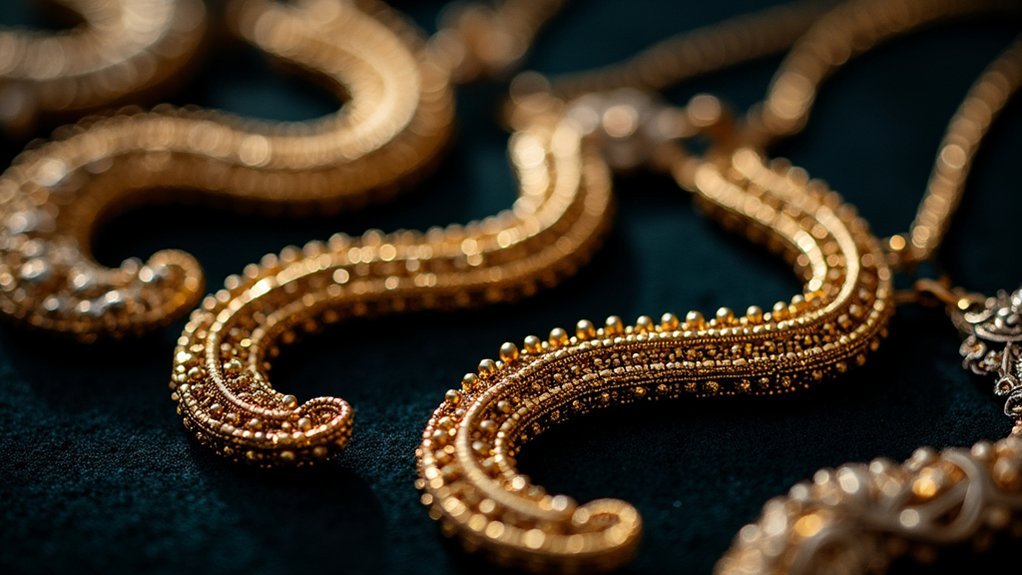
Beyond their decorative appeal, granulated jewelry pieces functioned as powerful indicators of an individual’s position within Viking social hierarchies. You’d find high-karat gold reserved exclusively for royalty and nobility, symbolizing divine favor and ultimate authority.
The intricate granulation techniques themselves demonstrated exceptional craftsmanship, marking the wearer’s elevated social status through artistic excellence. Silver ornaments with detailed granulated designs helped wealthy warriors and merchants display their ambition and standing, while bronze pieces remained accessible to middle-class Vikings.
When you wore specific motifs like Thor’s hammer crafted in granulated gold and silver, you weren’t just showcasing wealth—you were broadcasting personal beliefs and mythological connections. These ornamental choices created a complex visual language that immediately communicated your place within Viking society’s rigid hierarchy.
Ritual and Religious Significance of Granulated Amulets and Pendants
When Vikings crafted granulated amulets and pendants, they weren’t simply creating beautiful accessories—they were forging sacred objects that bridged the mortal and divine domains.
These sacred ornaments transcended mere decoration, serving as powerful conduits between earthly existence and the realm of the gods.
These intricate pieces served as protective talismans, believed to ward off evil spirits while attracting good fortune to their wearers.
The ritualistic aspect of these ornaments extended far beyond personal protection.
Archaeological evidence reveals three primary spiritual functions:
- Divine offerings – Granulated jewelry served as gifts to appease Norse gods
- Ceremonial tools – Used in religious rituals with traces of organic materials
- Burial accompaniments – Honored the dead in afterlife preparations
Norse mythology heavily influenced design choices, with Thor’s Hammer being particularly popular for its strength symbolism.
Gold and silver weren’t chosen randomly—Vikings believed these metals invoked divine favor and spiritual blessings.
Modern Revival of Viking Granulation Techniques in Contemporary Jewelry
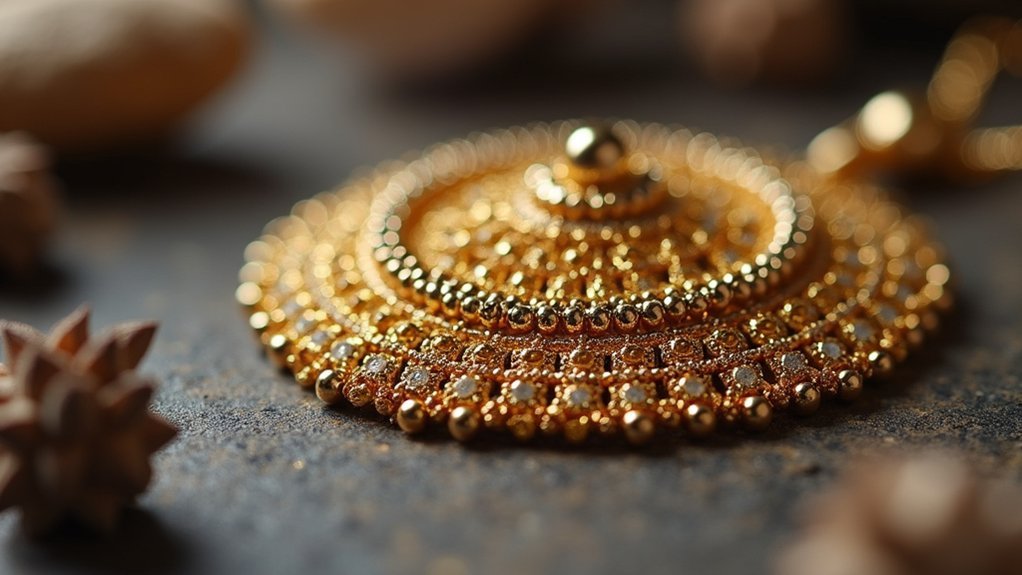
As modern artisans rediscover the lost art of Viking granulation, they’re breathing new life into techniques that once adorned medieval warriors and Norse nobility.
You’ll find contemporary jewelers drawing inspiration from these ancient methods, incorporating small metal granules to create intricate patterns that echo historical craftsmanship.
Today’s artisans employed various techniques using high-karat gold and silver alloys to replicate authentic Viking aesthetics.
You can now learn these traditional methods through workshops and classes, applying ancient granulation to contemporary jewellery design.
Modern interpretations successfully blend historical techniques with current fashion trends, appealing to both history enthusiasts and style-conscious consumers.
This revival has sparked renewed interest in handmade jewellery, reflecting our broader cultural fascination with Viking heritage and masterful artistry.
Frequently Asked Questions
How Do We Know About Viking Jewellery?
You’ll discover Viking jewelry through archaeological excavations at sites like Birka and Hedeby, burial sites containing artifacts, historical sagas and texts, plus museum collections that preserve these ancient treasures for study.
What Is the Most Common Viking Jewelry?
You’ll find arm rings were the most common Viking jewelry, serving as wealth symbols and currency. They also wore necklaces with glass beads and amber, plus functional brooches that fastened clothing.
What Metal Did Vikings Use for Jewelry?
You’d find Vikings using gold for elite status symbols, silver for intricate pendants with niello inlay, bronze for middle-class pieces with animal motifs, and pewter for affordable options among lower classes.
Why Did Vikings Wear Arm Rings?
You’d wear arm rings to display your wealth and social status among Vikings. They’d show your allegiance to leaders, serve as currency for transactions, and connect you spiritually to Norse gods while marking your achievements.
In Summary
You’ve discovered how Viking goldsmiths transformed ancient Etruscan granulation into their own distinctive art form. You’ve seen how they mastered colloidal soldering, created regional variations across Scandinavia, and imbued their jewelry with deep spiritual meaning. Today, you can witness this remarkable craft’s revival as modern artisans honor Viking heritage while creating contemporary pieces. You’re now connected to a timeless tradition that bridges ancient craftsmanship with today’s artistic expression.

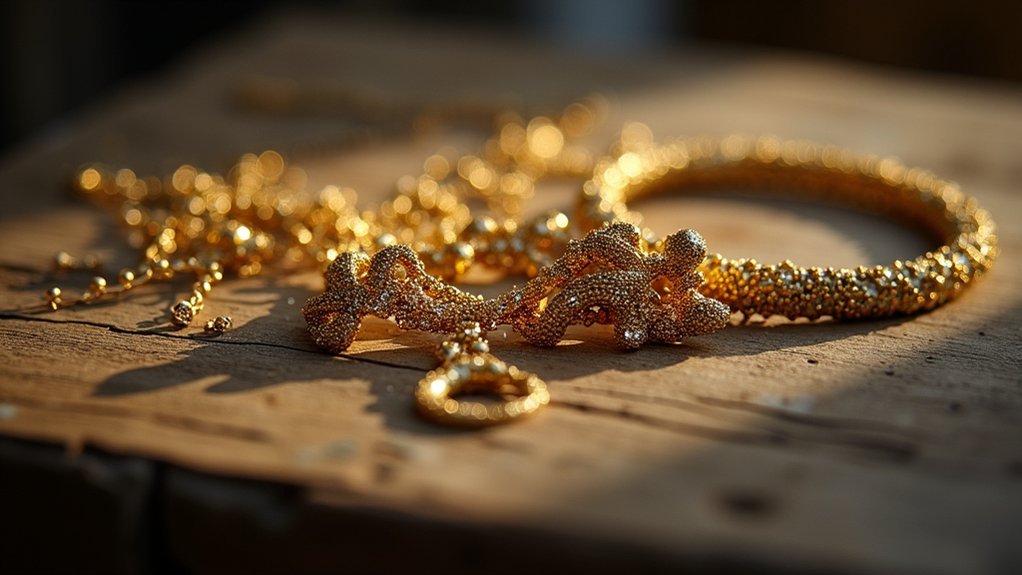
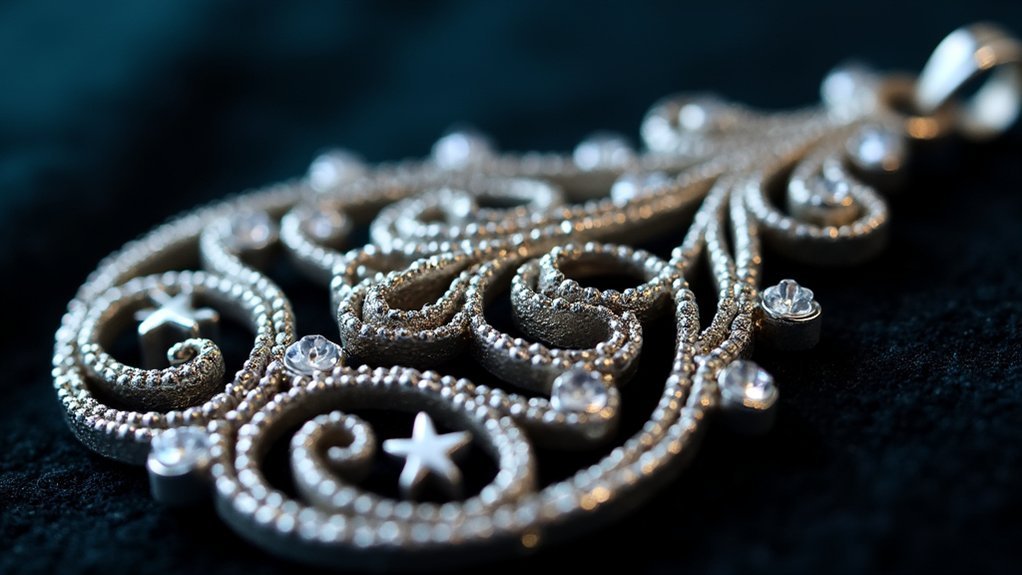
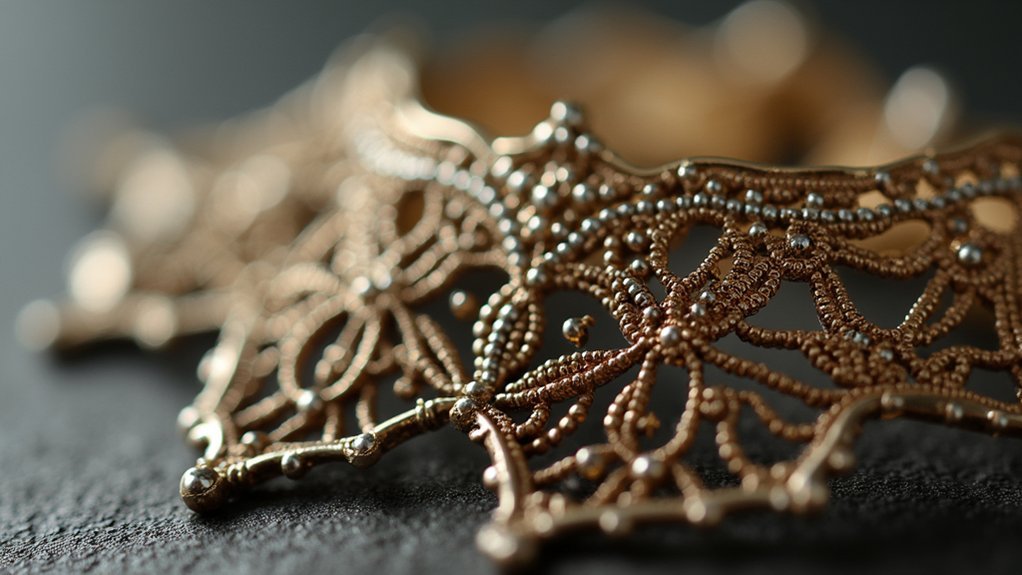
Leave a Reply